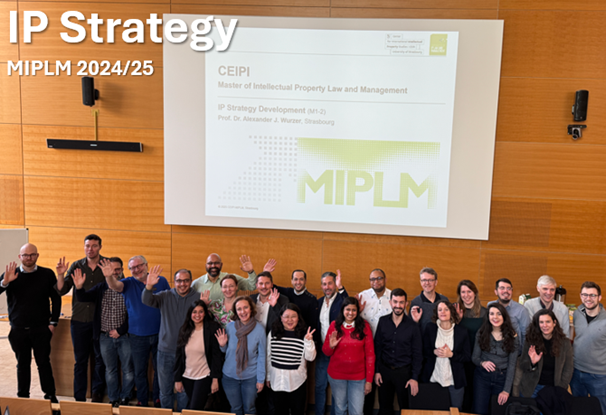IP Strategy: Unlocking Value and Driving Innovation in the Global Economy
The Center for International Intellectual Property Studies (CEIPI) at the University of Strasbourg kicked off its largest ever Master of Intellectual Property Law and Management (MIPLM) program this week, welcoming 28 students from around the globe. With participants hailing from Europe, the United States, Africa and Asia, this year’s cohort represents the program’s most diverse and international group to date. This is the first year that we are awarding the degree jointly with the European Patent Office.
The opening lecture, delivered by Professor Dr. Alexander J. Wurzer, set the stage for an intensive exploration of IP strategy and its critical role in today’s knowledge-based economy. As intellectual property increasingly becomes a key driver of competitive advantage and value creation for businesses worldwide, the MIPLM program aims to equip the next generation of IP leaders with the strategic mindset and practical skills needed to navigate this complex landscape.
The Evolution of Strategic IP Management
Professor Wurzer began by tracing the evolution of strategic management thinking, from its roots in military strategy to its application in modern business. He highlighted how the field has shifted from a purely market-based view focused on industry positioning to one that also emphasizes internal resources and capabilities as sources of competitive advantage.
🔎𝐈𝐏 𝐌𝐚𝐧𝐚𝐠𝐞𝐦𝐞𝐧𝐭 𝐆𝐥𝐨𝐬𝐬𝐚𝐫𝐲: Strategic Management
This evolution mirrors changes in the global economy, as intangible assets like intellectual property have become increasingly important value drivers for companies. No longer just a legal tool for excluding competitors, IP is now viewed as a strategic asset that can be leveraged to create and capture value in myriad ways.
The lecture outlined several key trends driving the growing strategic importance of IP:
- The shift to a knowledge-based economy where intangible assets represent a larger share of company value
- Intensifying global competition and shorter product lifecycles, increasing pressure to innovate
- The rise of open innovation models requiring more sophisticated IP management
- Growing recognition of IP’s role in accessing capital, especially for startups and SMEs
- Increasing complexity of technologies requiring larger patent portfolios and cross-licensing
📝𝗜𝗣 𝗕𝘂𝘀𝗶𝗻𝗲𝘀𝘀 𝗔𝗰𝗮𝗱𝗲𝗺𝘆 𝗕𝗹𝗼𝗴: The Fall and Rise of Strategic Planning
Frameworks for IP Strategy Development
A major focus of the lecture was introducing frameworks and tools for developing effective IP strategies aligned with overall business objectives. Professor Wurzer emphasized that IP strategy should not be developed in isolation, but rather integrated with and supportive of a company’s broader competitive strategy. He presented a comprehensive IP strategy development tool that considers:
1 . Strategic Analysis – Evaluating the external competitive landscape and internal resources/capabilities
2 . Strategic Objectives – Defining sources of competitive advantage and strategic direction
3 . Strategy Formulation – Developing plans for creating and capturing value from IP
The framework examines IP strategy through multiple lenses:
- Economic Effect – How IP can drive premium pricing or market share gains
- Appropriation – Mechanisms for capturing the value created by IP
- Impact – How IP influences competitive dynamics and stakeholder behavior
- Function – The different roles IP can play in supporting business strategy
Students were introduced to analytical tools like Porter’s Five Forces and value chain analysis, and shown how to apply an IP lens to these classic strategy frameworks. The goal is to identify how IP can be used to influence industry structure and competitive dynamics in ways that benefit the firm.
📝𝗜𝗣 𝗕𝘂𝘀𝗶𝗻𝗲𝘀𝘀 𝗔𝗰𝗮𝗱𝗲𝗺𝘆 𝗕𝗹𝗼𝗴: Strategic Management of IP
Generic IP Strategies
Professor Wurzer outlined several archetypal IP strategies that companies can pursue depending on their industry position and objectives:
- Fortress Monopoly: Building large portfolios to create strong entry barriers, common in pharmaceuticals and chemicals
- Value-Added Monopoly: Protecting user-relevant features to drive differentiation, seen in consumer products
- Hub Monopoly: Setting proprietary standards to control platform ecosystems, prevalent in tech and telecom
- Monopoly-in-a-Box: Well-defined portfolios covering core technologies, used by biotech and component makers
- Value Chain Monopoly: Controlling key steps in industry value chains, employed by industrial suppliers
The lecture emphasized that there is no one-size-fits-all approach. The appropriate strategy depends on factors like industry structure, a company’s competitive position, and its overall business model. Effective IP strategists must be able to analyze these factors and craft tailored approaches.
🔗𝗜𝗣𝗹𝗲𝘅: IP Strategy
Integrating IP into Business Models
A key theme was the importance of aligning IP strategy with a company’s broader business model. Professor Wurzer introduced tools for mapping IP to different elements of the business model canvas, showing how IP can support and enhance various aspects of value creation and capture.
He used the example of Vorwerk’s Thermomix kitchen appliance to illustrate how IP can be leveraged across multiple dimensions of a business model:
- Value Proposition: Patents on core technologies and designs protect unique features
- Customer Relationships: Trademarks support brand value and customer loyalty
- Channels: IP enables control of distribution channels and aftermarket
- Key Resources: Patents protect core competencies and know-how
- Key Activities: IP supports R&D and innovation processes
- Key Partners: IP facilitates partnerships and manages value chain relationships
- Revenue Streams: Licensing provides additional revenue opportunities
- Cost Structure: IP enables premium pricing and cost advantages
The case study demonstrated how a holistic IP strategy can create a defensible competitive position and drive long-term value creation. It also highlighted the importance of considering IP implications across all aspects of the business, not just in R&D or legal departments.
📝𝗜𝗣 𝗕𝘂𝘀𝗶𝗻𝗲𝘀𝘀 𝗔𝗰𝗮𝗱𝗲𝗺𝘆 𝗕𝗹𝗼𝗴: Case Study Vorwerk
Dynamic Capabilities and IP
The lecture touched on the concept of dynamic capabilities – a firm’s ability to integrate, build, and reconfigure competencies to address rapidly changing environments. Professor Wurzer discussed how effective IP management can enhance a company’s dynamic capabilities by:
- Enabling faster recognition and response to technological shifts
- Supporting more efficient knowledge integration and transfer
- Facilitating strategic flexibility through licensing and partnerships
- Enhancing absorptive capacity to leverage external innovations
He emphasized that in today’s fast-moving business landscape, the ability to rapidly sense and seize opportunities is often more important than static resource positions. IP strategy must therefore be dynamic and adaptive, continuously evolving to align with changing market conditions and business priorities.
🔎𝐈𝐏 𝐌𝐚𝐧𝐚𝐠𝐞𝐦𝐞𝐧𝐭 𝐆𝐥𝐨𝐬𝐬𝐚𝐫𝐲: Dynamic Capabilities
Measuring IP Strategy Effectiveness
The final section of the lecture addressed the challenges of measuring the impact and effectiveness of IP strategies. Traditional metrics like patent counts or licensing revenues provide an incomplete picture. Professor Wurzer introduced more holistic frameworks for assessing IP strategy performance, including:
- Economic value creation (e.g. premium pricing, market share gains)
- Strategic positioning (e.g. freedom to operate, blocking competitors)
- Organizational capabilities (e.g. innovation capacity, speed to market)
- Financial outcomes (e.g. ROI on IP investments, total shareholder return)
He stressed the importance of developing IP key performance indicators (KPIs) aligned with overall business objectives and strategy. This enables more effective communication of IP value to senior management and helps justify continued investment in IP assets and capabilities.
🔎𝐈𝐏 𝐌𝐚𝐧𝐚𝐠𝐞𝐦𝐞𝐧𝐭 𝐆𝐥𝐨𝐬𝐬𝐚𝐫𝐲: Value Chain
Preparing IP Leaders for a Complex Future
As the lecture concluded, Professor Wurzer emphasized that effective IP strategy in today’s digital business environment requires a diverse skillset combining legal, technical, and business acumen. The MIPLM program aims to develop T-shaped professionals who have deep IP expertise coupled with broad business and strategic understanding.
🔎𝐈𝐏 𝐌𝐚𝐧𝐚𝐠𝐞𝐦𝐞𝐧𝐭 𝐆𝐥𝐨𝐬𝐬𝐚𝐫𝐲: Industry 4.0
With its international cohort bringing diverse perspectives from around the globe, this year’s MIPLM class is well-positioned to tackle the complex IP challenges facing multinational enterprises. As technologies converge, industries blur, and innovation ecosystems become more interconnected, the ability to craft and execute sophisticated IP strategies will only grow in importance.
The energy and engagement of the students was palpable as they began to grapple with the frameworks and concepts introduced. Many expressed excitement about applying their learnings to real-world IP challenges in their organizations.
As the global economy continues to evolve, placing ever greater value on intangible assets and innovation, programs like CEIPI’s MIPLM will play a crucial role in developing the IP leaders of tomorrow. These professionals will be tasked with not just protecting innovations, but strategically leveraging IP to drive value creation and sustainable competitive advantage in an increasingly complex and fast-moving business landscape.
The MIPLM class of 2024/25 has embarked on an intensive journey to master these critical skills. If the opening lecture was any indication, they are in for a rigorous, enlightening, and potentially career-defining educational experience that will equip them to shape the future of IP strategy in organizations around the world.



